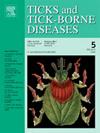从蜱唾液腺到唾液的病毒分泌的宏基因组证据:潜在的水平传播的含义
IF 3.4
2区 医学
Q2 INFECTIOUS DISEASES
引用次数: 0
摘要
蜱在吸血过程中通过唾液分泌将多种病毒病原体传播给宿主。本研究对在中国采集的4种蜱(过角蜱、微头蜱、长角血蜱和细角血蜱)成年蜱的唾液腺和唾液中的病毒成分进行了分析。元转录组学分析显示,不同物种间的病毒组差异明显,黄病毒科在微加河鼠中占优势,黄病毒科在concinna和persulcatus中占优势,而phenuivirus科在长角河鼠和persulcatus中占优势。在唾液腺中检测到的27种病毒中,有14种在唾液中检测到,表明有水平传播的可能。唾液腺中丰度较高的病毒(每百万碱基转录本,TPM)更有可能在唾液中分泌。利用唾液腺对与人类疾病相关或具有外溢性的8种病毒(包括发热伴血小板减少综合征病毒(SFTSV)、蜱传脑炎病毒(TBEV)、荆门蜱病毒(JMTV)、松林病毒(SGLV)、湿地病毒(WELV)、Beiji naiovirus (BJNV)、Mukawa病毒(MKWV)和武汉蜱病毒2型(WHTV2))进行了全基因组测序,并在唾液中进行了鉴定。值得注意的是,长角锥虫SFTSV;MKWV、四川蜱类肝炎病毒和吉林黄体样病毒2型;和JMTV在微加河鼠唾液中的丰度显著增加,表明这些病毒在唾液中的分泌增强。相反,在过sulcatus中的TBEV、BJNV和Sara tick lebovirus,在concinna中的SGLV和WELV,以及在microplus中的WHTV2,尽管存在腺体,但在唾液中丰度降低。这些发现证明了蜱传病毒(TBVs)从腺体到唾液的不同分泌能力,促进了对影响人类健康的病原体水平传播风险的理解。本文章由计算机程序翻译,如有差异,请以英文原文为准。
Metagenomic evidence of viral secretion from tick salivary glands to saliva: implications for potential horizontal transmission
Ticks transmit diverse viral pathogens to hosts during blood-feeding via saliva secretion. This study characterized viral compositions in salivary glands and saliva from adults of four tick species (Ixodes persulcatus, Rhipicephalus microplus, Haemaphysalis longicornis, and Haemaphysalis concinna) collected in China. Meta-transcriptomic analysis revealed distinct viromes across species, with Flaviviridae dominant in R. microplus, Nairoviridae in H. concinna and I. persulcatus, and Phenuiviridae in H. longicornis and I. persulcatus. Among 27 viruses detected in salivary glands, 14 were identified in saliva, indicating horizontal transmission potential. Viruses with higher abundance (transcripts per thousand bases per million, TPM) in salivary glands were more likely to be secreted in saliva. Genomic sequences of eight viruses, including severe fever with thrombocytopenia syndrome virus (SFTSV), tick-borne encephalitis virus (TBEV), Jingmen tick virus (JMTV), Songling virus (SGLV), Wetland virus (WELV), Beiji nairovirus (BJNV), Mukawa virus (MKWV), and Wuhan tick virus 2 (WHTV2), which are associated with human diseases or possess spillover potentials, were fully assembled from salivary glands and confirmed in saliva. Notably, SFTSV in H. longicornis; MKWV, Sichuan tick hepe-like virus, and Jilin luteo-like virus 2 in I. persulcatus; and JMTV in R. microplus showed significantly increased abundance in saliva, indicating an enhanced secretion of these viruses into saliva. Conversely, TBEV, BJNV, and Sara tick phlebovirus in I. persulcatus, SGLV and WELV in H. concinna, and WHTV2 in R. microplus exhibited reduced salivary abundance despite glandular presence. These findings demonstrate differential secretion capabilities of tick-borne viruses (TBVs) from glands to saliva, advancing understanding of horizontal transmission risks for pathogens affecting human health.
求助全文
通过发布文献求助,成功后即可免费获取论文全文。
去求助
来源期刊

Ticks and Tick-borne Diseases
INFECTIOUS DISEASES-MICROBIOLOGY
CiteScore
6.90
自引率
12.50%
发文量
185
审稿时长
6-12 weeks
期刊介绍:
Ticks and Tick-borne Diseases is an international, peer-reviewed scientific journal. It publishes original research papers, short communications, state-of-the-art mini-reviews, letters to the editor, clinical-case studies, announcements of pertinent international meetings, and editorials.
The journal covers a broad spectrum and brings together various disciplines, for example, zoology, microbiology, molecular biology, genetics, mathematical modelling, veterinary and human medicine. Multidisciplinary approaches and the use of conventional and novel methods/methodologies (in the field and in the laboratory) are crucial for deeper understanding of the natural processes and human behaviour/activities that result in human or animal diseases and in economic effects of ticks and tick-borne pathogens. Such understanding is essential for management of tick populations and tick-borne diseases in an effective and environmentally acceptable manner.
 求助内容:
求助内容: 应助结果提醒方式:
应助结果提醒方式:


